new posts in all blogs
Viewing: Blog Posts Tagged with: trains, Most Recent at Top [Help]
Results 1 - 25 of 31
How to use this Page
You are viewing the most recent posts tagged with the words: trains in the JacketFlap blog reader. What is a tag? Think of a tag as a keyword or category label. Tags can both help you find posts on JacketFlap.com as well as provide an easy way for you to "remember" and classify posts for later recall. Try adding a tag yourself by clicking "Add a tag" below a post's header. Scroll down through the list of Recent Posts in the left column and click on a post title that sounds interesting. You can view all posts from a specific blog by clicking the Blog name in the right column, or you can click a 'More Posts from this Blog' link in any individual post.
Railroad Hank. Lisa Moser. Illustrated by Benji Davies. 2012. Random House. 40 pages. [Source: Review copy]
First sentence:
Railroad Hank and his fine little train rolled down the track. Chugga Chugga, Chugga Chugga, Woo Woo Woo!! Railroad Hank stopped at Happy Flap Farm to talk to Missy May. "I'm headed up the mountain to see Granny Bett," said Railroad Hank. "She's feeling kind of blue." Premise/Plot: Railroad Hank is on a mission to cheer up Granny Bett. But, he's a bit clueless how to go about it. He's more than willing to listen to some good advice from the people he meets as his train rolls along. But is he really understanding their advice?! Not really. For example, Missy May advises him to take some eggs to Granny Bets because "scrambley eggs" always makes her feel better. So Railroad Hank takes some of the CHICKENS from Happy Flap Farm. By the time he's made it to Granny Bett's place, well, it's been quite a TRIP.
My thoughts: This one was very funny in a cutesy, country way. It is a bit over-the-top, I admit. After the initial advice, readers--adults and children--can probably predict how the rest of the trip is going to go. Which is a good thing in many ways. By the end, it had charmed me more than I thought it would have. Still it's probably not for every reader. But no book is after all!
Text: 4 out of 5
Illustrations: 4 out of 5
Total: 8 out of 10
© 2015 Becky Laney of
Becky's Book Reviews

By:
[email protected],
on 6/14/2015
Blog:
Perpetually Adolescent
(
Login to Add to MyJacketFlap)
JacketFlap tags:
loss,
trains,
children's picture books,
Melbourne,
teddy bears picnic,
nicki greenberg,
New Book Releases,
Allen & Unwin,
Dimity Powell,
Book Reviews - Childrens and Young Adult,
public transport,
Teddy Took the Train,
Add a tag
Loss is a natural part of life. Nearly all of us have experienced it, losing a pet, a loved one, a favourite piece of antique china, mental sanity. As adults, we are equipped with strategies and understanding enough to assist us to the next station in life, to get over it. However, when a child […]

By:
Becky Laney,
on 2/10/2015
Blog:
Becky's Book Reviews
(
Login to Add to MyJacketFlap)
JacketFlap tags:
circus,
trains,
2014,
MG Fiction,
library book,
MG Fantasy,
mg historical,
MG Adventure,
books reviewed in 2015,
Speculative Fiction Reviewed in 2015,
Add a tag
Boundless. Kenneth Oppel. 2014. Simon & Schuster. 320 pages. [Source: Library]
Three hours before the avalanche hits, William Everett is sitting on an upturned crate, waiting for his father. The town doesn't even have a name yet. If you love historical action-adventures with danger and mysteries and secrets and murders, then The Boundless might be a very good fit for you, especially if you love children's books, or circuses, or trains.
The first chapter serves as a prologue. It introduces the hero, of course, Will Everett, and many of the other characters as well. Readers learn that Will loves to draw. Will meets a mystery-girl that mesmerizes him, that will continue to mesmerize him for over three years. Will meets Cornelius Van Horne, the manager of the Canadian Pacific Railroad. Will gets invited to go along on a train ride. His father, James Everett, works for the railroad, they'll meet him at the end of the line. He'll meet several people on his journey. He'll hear things, see things. For example, he'll see the plans for the Boundless, and hear of this man's visionary idea for train travel. Things happen that will change his life forever.
The rest of the novel is set three years later and covers a short span--perhaps a week. In that week, much will happen. Will, the hero, will face DANGER and have to prove himself again and again and again. Will is many things, talented, for example, but courageous not so much. He is forced to risk much, to face many different kinds of threats and dangers. He also spends much of his time thinking and pondering.
Will has one idea of his future: what he wants, what he needs. His father has another idea. The two are opposites essentially. Part of him wants to completely reject his father's plans for him. Another part is scared. So when he's not actually at risk of dying, Will ponders the future.
I liked this one. I didn't love it. But I think for those that like action-adventure, this one could prove appealing.
© 2015 Becky Laney of
Becky's Book Reviews
 A fat cat thin or a thin cat fat? When Alleycat was young he was thin, but suddenly one day he became enormously fat, like a bear getting ready to hibernate, or like a cat leviathan.
A fat cat thin or a thin cat fat? When Alleycat was young he was thin, but suddenly one day he became enormously fat, like a bear getting ready to hibernate, or like a cat leviathan. But there was method and purpose behind his bulking-up. He was building his physical power in the knowledge that soon he’d be poisoned (and he was) but he got himself through his ordeal and burned off the poison by burning away his fat. He came near the Door of Death, and he saw through it, and who knows what arcane knowledge he glimpsed out of the edge of his cat’s eyes in those days when the prison was attacking him. But now the poison’s gone and he’s as thin and fit as he was when he was young, and as for me I’m a little bit fatter than I’d like to be, so Alleycat and I have started running together. We jog together along the disused railway line near my house, and sometimes we stop and listen for the ghostly whistling of the old-time trains. By the way, it’s Alleycat in both of the photos, fat and young at the top, old and thin at the side.
But there was method and purpose behind his bulking-up. He was building his physical power in the knowledge that soon he’d be poisoned (and he was) but he got himself through his ordeal and burned off the poison by burning away his fat. He came near the Door of Death, and he saw through it, and who knows what arcane knowledge he glimpsed out of the edge of his cat’s eyes in those days when the prison was attacking him. But now the poison’s gone and he’s as thin and fit as he was when he was young, and as for me I’m a little bit fatter than I’d like to be, so Alleycat and I have started running together. We jog together along the disused railway line near my house, and sometimes we stop and listen for the ghostly whistling of the old-time trains. By the way, it’s Alleycat in both of the photos, fat and young at the top, old and thin at the side.


We uncovered lots of fascinating pieces of Disney history while working on Ward Kimball’s biography—you know, the one that the Disney Company’s lawyers won’t allow you to see. Among the discoveries were film reels of Ward’s home movies, which I can report are a fair deal more interesting than the average person’s home movies.
We transferred those reels, and with permission, I’m sharing a rarely seen piece of movie footage shot by Ward. Tomorrow, it will be exactly 65 years since this film was recorded (April 4, 1948). In it, Ward and Walt Disney visit the home of Dick Jackson, a wealthy businessman who operated a scale-railroad in the backyard of his Beverly Hills home.
Kimball had been a close friend of Jackson’s for years, and often dropped by for steamups. A little over six years earlier—December 7, 1941, to be exact—as he was driving to Jackson’s for a steamup, he heard on the radio that Pearl Harbor had been bombed. The news unsettled him momentarily, but he “forgot it all with Jackson’s locomotive,” he wrote in his journal. Backyard railroading had the magical effect of allowing people to put the real world on pause, even if only for a few hours at a time.
In spring 1948, Ward had become aware of Disney’s budding interest in scale-model trains, and he invited Walt to come along to Jackson’s place for an afternoon of scale railroading. This is, I believe, the first time that Walt had ever personally operated scale-trains. Walt was hooked after the visit, and soon after he began constructing his own luxe backyard railroad, the Carolwood Pacific.
Kimball’s unusually close relationship with Disney allowed him to capture these unguarded moments of his mercurial boss. Disney appears to be enjoying every hunched-over second of the railroading experience, and he takes the time to acknowledge Ward’s camera on multiple occasions. Ward wrote about the day’s events in his private journal:
Sunday, April 4, 1948
Up with bright sun. Kids helped me put nitrogen around orange trees. If they didn’t, no Jackson train ride. Damp grass. At 12:45 left for Jacksons in Beverly Hills. 1st over there. He started the Colorado Central. Steam up at 2:00. Walt Disney arrived soon after. Got a big kick out of it all. We showed him the works. He couldn’t quite believe that it was all scale! He tried it out—got scared when drivers spin. “What the hell was that!” he’d ask me. He had lots of fun. We all took movies and Jackson took stills. Showed Walt Jackson’s shop. Kids rode and played “Train Robbers.” Home at 5:30. Broiled corn beef over fire place.
The original film is silent so I added some music—of course, Kimball’s band The Firehouse Five Plus Two. Below are identifications of the people in the film, including Ward’s wife Betty and their three children:
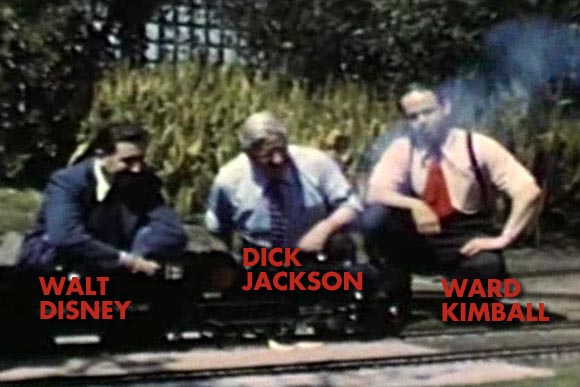
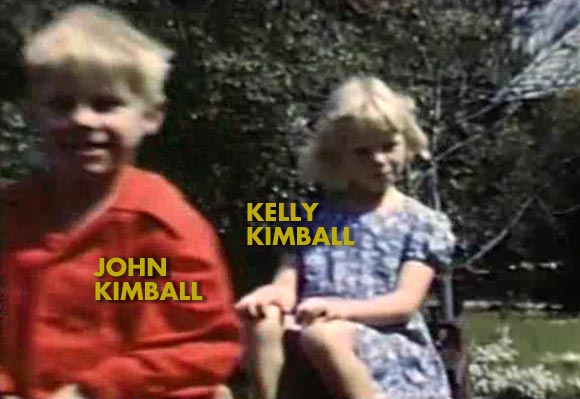
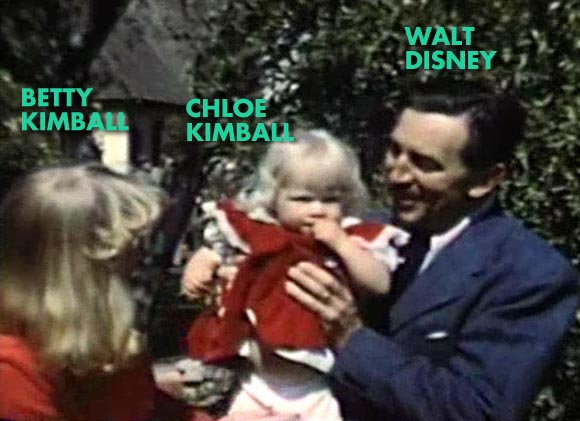
By:
KidLitReviews,
on 12/17/2012
Blog:
Kid Lit Reviews
(
Login to Add to MyJacketFlap)
JacketFlap tags:
Children's Books,
reviews,
family,
running,
friendship,
literacy,
pig,
book review,
picture books,
emotions,
illustrations,
circus,
goat,
picture book review,
children's book,
trains,
competition,
plane,
chicken,
boats,
hay stack,
cow,
duck,
childrens book review,
picture book illustrations,
bicycles,
hot air balloon,
helping friends,
early learning,
chasing,
barge,
caught,
4stars,
Library Donated Books,
Chasing Watermelons,
watermelon feast,
bi-plane,
chidren's book illustrations,
Chimeric Press,
circus tent,
companionship,
crates,
cut watermelon,
Kevin White,
Kid Lit Reviews,
Rex White,
river boat,
trust,
watermelons,
Add a tag
4 Stars Chasing Watermelons Kevin White Rex White 32 Pages Ages: 3 to 6 ……………… Press Release: When Duck opens a crate of watermelons for a watermelon feast, they begin to roll. Duck chases after them. One by one, Duck invites Goat, Pig, Chicken, and Cow to join the chase by promising, “If you help, [...]
By:
KidLitReviews,
on 11/13/2012
Blog:
Kid Lit Reviews
(
Login to Add to MyJacketFlap)
JacketFlap tags:
5stars,
Papercutz,
Library Donated Books,
Bob Cratchit,
Estelle Meyrand,
Mugby,
Rodolphe,
train racks,
relationships,
classics,
Graphic Novel,
Christmas,
snow,
Middle Grade,
Favorites,
London,
Scrooge,
trains,
families,
Charles Dickens,
A Christmas Carol,
Holiday Book,
Tiny Tim,
Add a tag
5 Stars Scrooge: A Christmas Carol & A Remembrance of Mugby Charles Dickens Papercutz 96 Pages Ages: 8 and up Scrooge is actually two books in one. In addition to the traditional Dickens classic A Christmas Carol there is also another Charles Dickens classic, A Remembrance of Mugby. Chances are good you have not [...]

By:
Melissa Wiley,
on 10/9/2012
Blog:
Here in the Bonny Glen
(
Login to Add to MyJacketFlap)
JacketFlap tags:
Assorted and Sundry,
Donald Crews,
The Prairie Thief,
passionflower,
Books,
reviews,
trains,
Virginia Lee Burton,
Dorrie the Little Witch,
Anna Elizabeth Bennett,
Little Witch,
Add a tag
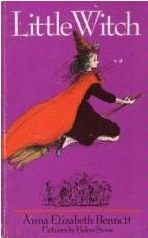 Choo-Choo by Virginia Lee Burton. (She’s one of Huck’s favorite author/illustrators, going by how often he requests her books.)
Choo-Choo by Virginia Lee Burton. (She’s one of Huck’s favorite author/illustrators, going by how often he requests her books.)
Freight Train by Donald Crews. (You may detect a theme.)
Little Witch by Anna Elizabeth Bennett. (Chapter 1, to Rilla. I remember riding my bike to three different library branches in search of this book—not all on the same day—because I’d read it and loved it so, and couldn’t remember the author’s name later, only that it began with B. Today it would take my mom ten seconds on the library website to locate a copy. Back then it meant a bona fide, muscle-burning quest, and all in vain. I couldn’t find it. Years later, when I took a job at HarperCollins, I discovered that it was a Harper book, still in print. And yet somehow I didn’t reread it. This go-round with Rilla will be my first time in decades. I’m eager to see if it holds up to the glowing memories I have of that first reading so long ago. Minikin, nicknamed Minx! I got goosebumps. It’s out of print again, I see: pity.)
Speaking of Little Witches, it’s time to put another round of Dorrie books on hold at the library. One, two, three, ten…there, I’m done, no bicycle required.

Karen Edmisten made my day with a delightful account of a Prairie Thief luncheon held by her daughter’s book club. Potato chowder, dried berry scones, a bucket of hazelnuts (brilliant!), and brownies, of course. They even brewed some horseradish tea, which demonstrates an impressive degree of commitment. Thanks, Karen, for that wonderful post.

This morning we discovered that the passionflower vine I planted ages ago had snaked its way halfway across the butterfly garden. We untangled the wandering tendrils and tied them up along the back fence. I have every suspicion that it is out there right now, busily untying itself, and I’ll find it embracing the hibiscus bush tomorrow.
By:
TCBR,
on 9/5/2012
Blog:
The Children's Book Review
(
Login to Add to MyJacketFlap)
JacketFlap tags:
Trent Reedy,
David Clemesha,
Ages 0-3,
Ages 4-8,
Ages 9-12,
Trains,
featured,
Transportation,
Trucks,
Brian Biggs,
William Low,
Andrea Zimmerman,
Steve Light,
Add a tag
By Nina Schuyler, The Children’s Book Review
Published: August 9, 2012
What is it about boys and wheels? Yes, I’m making a gross generalization and relying far too heavily on anecdotal evidence, but I don’t see our neighbors with daughters outside at 6:30 am on Garbage Day, watching the parade of garbage trucks go by. All to the delight and squeals of my 14 month old son, a son who bolts up in bed when he hears the first rumble of the trucks. A son whose bedroom rug is decorated with things that go– airplanes, fire trucks, cars, trains, and helicopters—and it is the wheel, that black round object, to which he points and drools.
In honor of boys and things that go, here are a handful of new books that celebrate the wheel.
Picture Books
By Steve Light
Steve Light, the author and illustrator of Trains Go knows the allure of trains. It’s not just the rattle and clang or the choo choo or whoosh, it’s the length. How the train just keeps going by, car after car, as if it will never end. Light uses watercolor and black ink and beautifully illustrates trains –freight and diesel and speed and more. When you open the page, the train stretches to two feet. That’s a lot of train!
Ages 1-5 | Publisher: Chronicle Books | January 25, 2012
By Andrea Zimmerman and David Clemesha
In Train Man, by Andrea Zimmerman and David Clemesha, we enter the realm of a boy’s imagination as he considers what he’ll be when he grows up. A train man, without a doubt, with a train man hat and overalls. As the story progresses, his toy train turns into a big engine and he is at the helm, traveling up the mountain and back down again, then finally into his room with his track and miniature trains.
Ages 2-5 | Publisher: Henry Holt and Co.| March 13, 2012
By William Low
Since I received this book a couple weeks ago, my son has picked it up probably fifty times. (You’ll see why in a second). William Low’s Machines Go to Work in the City opens with a garbage truck. “Vroooom! Here comes the garbage truck, making its run! When the truck makes its last pickup, are the garbage collectors done for the day?” The page on the left folds out or up or down to give you the answer: “No, they must go to the landfill to empty the trash.” (And then I launch into a discussion of how we want to try to recycle because look at that yucky landfill. Never too early to start, I suppose). That’s the pattern of the book as it moves through commuter trains, vacuum trucks, tower cranes and airplanes. After the umpteenth reading, my son now says very clearly and distinctly the word, “No.”
Ages 2-6 | Publisher: Henry Holt and Co.| June 5, 2012
By Brian Biggs
Everything Goes On Land by Brian Biggs illustrates the entire page, using lots of color and capturing the sense of a city with its busyness and packed streets. We move through the city with a little boy and his father, who is driving. They see cars, trucks, RVs, bikes, buses, motorcycles, subway and trains. The book is interspersed with detailed explanations about particular vehicles. We even get to learn about how an electric car works. Biggs has a wonderful sense of the silly, letting the dogs and birds talk. He’s also built in a sort of I Spy game with birds wearing hats and random things that just don’t belong.
Ages 4-8 | Publisher: HarperCollins | September 13, 2011
A Chapter Book
By Trent Reedy
Trent Reedy in Stealing Air has a keen sense of what might appeal to a young boy– not only things that go, but boys who build rocket bikes and real airplanes in secret sheds.( Yes, a bike that with a flip of a switch zooms down the road.) Brian, a newcomer to Iowa, makes friends with Max, who shares with him his secret—in a hidden shed, he’s building a real airplane that looks like a flying motorcycle. But Max is afraid of heights so he solicits help from Brian and Alex, the popular kid from school, to serve as pilot and co-pilot. If the plane is ever to get off the ground, the boys have to overcome fights at home, at school, and a bully named Frankie.
Ages 8-12 | Publisher: Scholastic, Inc. | October 1, 2012
Nina Schuyler’s first novel, “The Painting,” was nominated for the Northern California Book Award and was named a ‘Best Book’ by the San Francisco Chronicle. Her next novel, “The Translator,” will be published by Pegasus Books in New York, Spring, 2013. She is the fiction editor for www.ablemuse.com and teaches creative writing at the University of San Francisco.
Original article: Kids Car Books & Things That Go: Airplanes, Fire Trucks, & Trains. Oh, My!
©2012 The Childrens Book Review. All Rights Reserved.

 On the Blue Comet by Rosemary Wells. Candlewick, 2010.
On the Blue Comet by Rosemary Wells. Candlewick, 2010.
On the Blue Comet was a pure joy to read. My childhood memory of pressing my cheek against the train board to gain a eye/ground level view of the trains was echoed in this story. The story's main character, eleven year old, Oscar Ogilvie is a kindred spirit as he performs the same ritual. We both were trying to imagine ourselves into the small world of the trains.
When I was a child, we had a model train set up. We did not have a basement but my father designed a over-sized folding platform for our HO model trains which included a train we had actually ridden on, the Santa Fe Railway Super Chief.
Wells sets her story during Great Depression. Oscar and his father share a love of model trains and they have an elaborate set up in the basement of their house. Each year they add to their collection but the hard economic times have put a stop to that. In fact, things are so bad that they must sell the train set to the local bank manager who uses the trains as a display in the bank lobby. Oscar's father leaves to look for work in California, promising to send for Oscar when he finds some. The kindly night watchman at the bank allows Oscar to visit and run the trains after the bank closes. One night the lobby is invaded by bank robbers and Oscar escapes into time and an unlikely landscape.
This story mixes history, time travel, and fantasy along with cameo appearances by some famous people in history. A great deal of the reading fun was identifying the people Oscar comes in contact with.
Bagram Ibatoulline has contributed glowing paintings that have been meticulously researched. Period fashion and architecture are reflected in illustrations which allow the reader to reach back in time too.
The book reminds me of how much model trains added to our childhoods. We learned -- hands-on --about electricity, direct current, transformers as well as trouble-shooting, patience and craftsmanship.
My kids have some sort of superhuman radar when it comes to locating books about trains. One of the books they insisted on bringing home from the library a while back was
Friday's Journey. It just happened to be set in the city, too.
In Ken Rush's
Friday's Journey
, Chris' parents are divorced and his dad has come to pick him up for their Friday journey, which is a subway ride to Dad's place, where he spends the weekend. During the train ride, Chris imagines the places the train could take him: places he used to go with both his parents. In the end, he realizes he can still enjoy those places just with Dad.
The story fell a little short for me, but I imagine it has a place among the targeted audience. However, there are a number of specific subway experiences that my young listeners grabbed on to, which is why I'm including a review on this blog. For example: the distant lights of the subway in the tunnel, the experience of watching the tracks out the front window, the screeching noise of the train stopping in the station. The city is obviously New York City, but it is never mentioned by name and because of the book's theme of living with divorced parents this book will find an audience outside the local one.
Want More?My favorite book about a dad and his sons riding the subway is the ingenious
Subway
by Christopher Niemann.
Little Kid says: Where is that train going?
By:
smmorris,
on 11/21/2011
Blog:
Kid Lit Reviews
(
Login to Add to MyJacketFlap)
JacketFlap tags:
5stars,
America's roads,
dirt roads,
Model-T,
National Road,
National Road Stage Company,
Children's Books,
picture book,
Middle Grade,
Favorites,
trains,
middle grades,
railroads,
bicycles,
1800,
Interstate,
Add a tag
5 Stars “Mr. John Slack, the keeper of the tavern beside a rutted dirt road in the early 1800s, thought things were just fine the way they were. So did Lucious Stockyon, who ran the National Road Stage Company in the mid-1800s. So too, the owners of the railroads when the first Model-T appeared in [...]

By: shelf-employed,
on 10/10/2011
Blog:
Shelf-employed
(
Login to Add to MyJacketFlap)
JacketFlap tags:
nocturnal animals,
rhyming,
book review,
dogs,
trains,
elephants,
owls,
storytime,
quirky,
E,
Add a tag
My calendar's packed. I just returned from a trip. I'm in the midst of a class. I'm presenting at a forum this week. But wait, four great new picture books are sitting on my table waiting to be reviewed!
What to do? Do it Twitter-style! Here they are in 140 characters or less:
 Willy
Willy. De Kockere. 2011. Erdman. Celebrating the peculiarities that make Willy the elephant special. Monty Python-esque art, a perfect foil to a quirky tale. Love it!
- Train Trip. Caswell. 2011.Hyperion. Cheerful and rhyming, a boy and a train bond during a trip. “Special treat. “Come on in!” “Sound the whistle?” Eager grin."
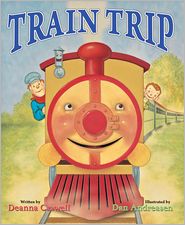
- Little Owl’s Night. Srinivasan. 2011. Viking. An owl observes the night’s activities. Dark colors, cheery wide-eyed creatures. Simple and serene.

- Shaggy Dogs, Waggy Dogs. Patricia Hubbell. 2011. Marshall Cavendish. Happy, rhyming, romping dogs. Dogs, dogs and more dogs! A storytime gem.
And one more of Willy, in case you didn't get enough!
 |
| ©Copyright Carll Cneut |
(Yikes! I forgot that MSWord doesn’t count spaces. Now I’ll have to be more clever!)

By: Storied Cities,
on 9/12/2011
Blog:
Storied Cities
(
Login to Add to MyJacketFlap)
JacketFlap tags:
Picture Book,
Birds,
New York City,
Traffic,
Trains,
Pre-K,
Concept Book,
K-3,
3 and under,
Add a tag

 It seems like I am always writing about books set in New York City! That is not intentional, but there certainly are an abundance of them.
It seems like I am always writing about books set in New York City! That is not intentional, but there certainly are an abundance of them.
I'm quite surprised I have never come across Where Are You, Little Zack? before. Co-written by Judith Ross Engerle and Stephanie Gordon Tessler, Where Are You, Little Zack?
before. Co-written by Judith Ross Engerle and Stephanie Gordon Tessler, Where Are You, Little Zack? is a classic tale of "lost in the city." The authors have added in a fun counting exercise, so while 3 ducks, Brick and Brack and Thackery Quack search for their brother, they are joined by 4 busy commuters, 5 taxi drivers... you get the idea. They are also joined by 80,000 Yankee fans, but don't worry, you don't have to count that high. Of course, the brothers are united in the end (after traveling on the number 9 train on the number 10 track) and all is well.
is a classic tale of "lost in the city." The authors have added in a fun counting exercise, so while 3 ducks, Brick and Brack and Thackery Quack search for their brother, they are joined by 4 busy commuters, 5 taxi drivers... you get the idea. They are also joined by 80,000 Yankee fans, but don't worry, you don't have to count that high. Of course, the brothers are united in the end (after traveling on the number 9 train on the number 10 track) and all is well.
Around here, we are big fans of Brian Floca's illustrations, but I think it's interesting he does not list this book on his website. True, it's not as spectacular as his more recent books, such as Moonshot and Ballet for Martha
and Ballet for Martha , but his artwork is still appealing. Even while the duck brothers are still searching, little eyes can locate Little Zack playing among the many landmarks of the city. The search also takes the reader to locations high and low, wet and dry, crowded and sparse, and fast and slow around New York. The reader will certainly understand that the city is a varied and interesting place!
, but his artwork is still appealing. Even while the duck brothers are still searching, little eyes can locate Little Zack playing among the many landmarks of the city. The search also takes the reader to locations high and low, wet and dry, crowded and sparse, and fast and slow around New York. The reader will certainly understand that the city is a varied and interesting place!
This book is lots of fun, and judging by the lack of reviews on Amazon, I'm guessing it's not well-known, which I find surprising. I think it would be a lov

 Since I started this blog project I have become intrigued by the many different ways the city can figure in a picture book. The city is not always the star of the show, sometimes it remains quiet, in the background. Yet it is always there, creating an aura of adventure.
Since I started this blog project I have become intrigued by the many different ways the city can figure in a picture book. The city is not always the star of the show, sometimes it remains quiet, in the background. Yet it is always there, creating an aura of adventure.
Amy Hest's The Purple Coat , is not about the city. Gabrielle wants, this year, to have a purple coat, not a navy blue one like she has always had. The book is a charming story of how Gabrielle and her grandfather come up with a new idea for her coat and how they convince her mother to compromise on the new color.
, is not about the city. Gabrielle wants, this year, to have a purple coat, not a navy blue one like she has always had. The book is a charming story of how Gabrielle and her grandfather come up with a new idea for her coat and how they convince her mother to compromise on the new color.
What interested me most about the book is the role the city plays. Every fall, Gabrielle and her mother take two trains, arriving through busy Penn Station in New York City where Gabrielle's grandfather is a tailor "on the twenty-eighth floor in a fancy office building that is even taller than that. " By the time the pair reach the tailor's shop in an elevator that is "too fast and too crowded" the city has retreated into the background. The rest of the action may take place in the quiet seclusion of grandfather's shop, but the city is still there. Illustrator Amy Schwartz has wisely included frequent glimpses of the city out the the windows. One of my favorite moments in the book is when the grandfather, contemplating Gabrielle's request for a purple coat, stands looking out the window at the city. It's as if the city, with all of its infinite variety of people and places provides the perfect reminder that one need not always have the same blue coat every year.
The beginning of this book reminded me of how exciting I found trips to the city when I was young (in my case it was San Francisco). The excitement of heading off to the city and the strangeness of the crowds must have added to Gabrielle's nervousness of asking for a purple coat.
The big city and a new purple coat: it's what every girl dreams of.
Want More?
Read A New Coat for Anna, a very different story set in a post-WWII European city (Berlin?). Someone (not me) should write a comparison of the two books.
Visit Amy Hest's website.
Read an interview with Amy Schwartz at Seven Impossible Things Before Breakfast.
Big Kid says: They had to take two trains to get to Penn Station? I wonder what train they took to the shop. That sign says the 1, 2 and 3. [You can see where his interest lies... not with purple coats.]
 Starting in the morning when everyone wakes up, yawning and ending at night, when "moms and dads are home at last," Christine Loomis' Rush Hour
Starting in the morning when everyone wakes up, yawning and ending at night, when "moms and dads are home at last," Christine Loomis' Rush Hour is a rhythmic, rhyming whirlwind tour of the adventure that is every city commuter's day.
is a rhythmic, rhyming whirlwind tour of the adventure that is every city commuter's day.
Little Kid is so obsessed with this book, he can "read" it page by page to himself. I'm not surprised. Loomis' uses words guaranteed to give any toddler and preschooler a heady buzz: "Whizzing, zipping, clickety clack, rumbling, roaring, jiggling, jumping, left turn, right turn, backing, bumping."
Mari Takabayashi's illustrations are busy, busy, busy, reflecting the crowds and bustle of the city. What I like best is the immense variety of experiences she illustrates. For example, when "people have begun their jobs," she doesn't stop at the standard police officer, teacher and business person -- there are more than 20 careers pictured. There are small details one might not normally think about: a man retrieves his mail from a row of apartment post boxes, a kitchen lacks adequate counter space, in the middle of the day, subway platforms are much emptier. It's the kind of city life detail I enjoy seeing in urban picture books.
Even though the city depicted is New York, none of the text is specific to NYC. I almost wish that the pictures were more city-generic, but of course my boys like to recognize the buses and trains they see everyday.
If your kid loves things with wheels, this book is sure to be a hit. But you might have to read it 12 dozen times.
Fair warning.
Want more?
Visit the illustrator's website.
Watch this you tube video of a crowded subway in Japan. Can you imagine if we had these white gloved "helpers" in NYC!
Little Kid says: Rush Hour , please!
, please!
So if we consider the figures, I appear to be a slacker this weekend. No work on the NaNoWriMo novel. Early last week, I considered trying to hit 60,000 words by the 30th, but my conscience urged me to take the weekend off and finish up and edit a short story with a December 1st deadline. And I just did. I can't add any words to my official word count as I spent today in third draft territory and then line editing, but Dehydrated Human Heart is on its way to...Rejectionville. Hey, best to be prepared.
In other news, froze my butt off at a railway station this morning. After overnight babysitting duty for my niece and nephew and waking up to minus 4 degrees (brr! Still chipping the ice off my eyeballs), the train to Liverpool was cancelled and then the next was cancelled, and they only run every half hour. So, it was a trip across the road to the taxi station and an expensive journey home. I do love British transport.
In worse news, I fell asleep during the last fifteen minutes of Sweeny Todd. I hang my Tim Burton loving head in shame.
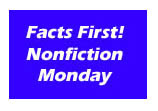
 Dewey 385
Dewey 385
Ultimate Trains written by Peter McMahon, illustrated by Andy Mora. KidsCan Press, 2010 (review copy from publisher)
written by Peter McMahon, illustrated by Andy Mora. KidsCan Press, 2010 (review copy from publisher)
Peter McMahon sees trains as an important part to be part of transportation's future. Touting them as a greener alternative to airplanes and cars he tracing the history of trains from their horse drawn days, through steam engines, diesel and on to magnetic levitation designs. The quest for power and speed is reviewed, accompanied by clean-line illustrations and diagrams by Andy Mora.
Hands-on experiments to illustrate the concepts in the book include, "Steam Engine in a Salad Bowl," "Riding the Rails," "Make your Own Electromagnet," and "Making a Maglev Test Track." There are templates of tracks and trains to photocopy (please, don't cut up the library book.) All the experiments are very do-able with parental help to acquire wires, copper tubing, nails, batteries and other sundry supplies. The final project, "Make a Working Maglev Model" requires lumber and Lexan (polycarbonate) which is more challenging.
Detailed plans and photos of the projects are available on the
KidsCanpress website.
This is the first book in a Machines of the Future series.
 Dewey: 578.734
Dewey: 578.734
Looking Closely in the Rain Forest
by Frank Serafini. KidsCan Press, 2010
0 Comments on NonFiction Monday: KidsCan Press as of 1/1/1900
In the interest of full disclosure, I need to make a confession: I am a former railway conductor. I worked for Midland Mainline, a railway operating company in England, for four years, working my way up from trolley dolly to guard. There was a time when I knew every bump in the line from Sheffield to London. Whenever I stand on a station platform, and watch a train leave, I am sorry for the

By: shelf-employed,
on 10/4/2010
Blog:
Shelf-employed
(
Login to Add to MyJacketFlap)
JacketFlap tags:
trains,
inventions,
Non-Fiction Monday,
picture books for older readers,
Underground Railroad,
bio,
inventors,
E,
African Americans,
history,
nonfiction,
Add a tag
Kulling, Monica. 2010.
All Aboard! Elijah McCoy’s Steam Engine. Ill. by Bill Slavin. Ontario, CA: Tundra.
One of the things that I love about reviewing children’s nonfiction is the number of new things that I learn every day. Today I learned a little-known, but interesting and inspirational life story, as well as an interesting tidbit of etymology, the origin of the phrase “the real McCoy.”
Get on Board!
we hear our conductor
singing low
the song she uses
to let us know
now is the time
to get on board...
the midnight train
runs underground
we hide and pray
not to be found
we risk our lives
to stay on board...
So begins
All Aboard! But
All Aboard! is not the story of the Underground Railroad, rather it is the culmination of the Underground Railroad's greater purpose - a self-determined, productive life, lived out in freedom. Elijah McCoy was the son of slaves who escaped to Canada on the Underground Railroad. His determined and hardworking parents saved enough money to send Elijah to school overseas, where he studied to become a mechanical engineer.
He returned in 1866 to join his family in Michigan. Though he may have been free, his opportunities were not equal. Despite his education, he was only able to secure work as an "ashcat," feeding coal into the firebox of a steam engine for the Michigan Central Railroad,
What a letdown! Elijah knew engines inside and out. He knew how to design them. He knew how to build them. He also knew the boss didn't think much of him because he was Black. But Elijah needed work, so he took the job.
Still, Elijah persevered in his job while his mind, trained in engineering, sought to find a solution to the miserable job of "grease monkey," the boys (including Elijah) who oiled all of a train's gears when they frequently seized up due to friction and lack of lubrication. Trains of the time were typically stopped every half hour or so for greasing. After several years, Elijah invented (and patented) an oil cup, which was used successfully to keep the trains running. Travel by train became faster, safer, and more efficient. He continued to invent throughout his life, eventually filing 57 patents! Others tried to copy Elijah McCoy's oil cup, but none were able to match his success.
When engineers wanted to make sure they got the best oil cup, they asked for the real McCoy.
All Aboard! Elijah McCoy's Steam Engine is an obscure but inspiring story, made particularly poignant by the juxtaposition of his parents' Underground Railroad experience, and his own experience working for the Michigan Central Railroad. The dialogue is invented and there are no references cited, however, the engaging story is simply told in a manner that makes complex topics like the inventive process and racism accessible to young readers.
All Aboard! is short enough that it can easily be read aloud to a classroom or storytime for older children.
The book's pen and watercolor illustrations are colorful, and full of life and expression; the reverse side of the dust jacket doubles as poster. The cov

The Last Train by Gordon Titcomb, illustrated by Wendell Minor
Based on a song by Gordon Titcomb, this book celebrates the days of the steam engines and small depots. A modern child visits the decrepit old depot in his town, the rusty tracks that no long gleam. He thinks about his grandfather and father and the work they did on the railroad. He dreams of huge engines and shiny cars streaking past. His box of memorabilia has plenty of memories stored inside of the glory days of the railroad. Titcomb’s words are enduring as he speaks to the wondrous power of the steam locomotive and the days when they ran. Minor’s art brings both modern days and history to life in warm colors, allowing young train enthusiasts to dream along with him about the power of steam.
Titcomb’s song and this book really celebrate the steam engine and the magic that those days still hold for modern children. The entire book is nicely summed up in the final lines:
A blast of steam,
the whistle screamed its mournful last refrains,
Long silent, though its echo still remains.
The words are poetry, they rhyme and dance, chugging along at times, at others sleekly gliding past. He captures the joy of the rails perfectly.
Minor’s art is celebrates the trains too. From the engine in the darkness under a star-filled sky to the caboose disappearing as the snow blows in. But he also celebrates a child’s relationship with trains. His old depot is filled with details that bring it to life. His meadows of flowers serve as a backdrop to the aging railyard. His flattened coins remind us all of sunny days and the surprising warmth of a smashed coin after the train goes by. In short, he shows us just why we all love trains.
A beautiful book, this is sure to be enjoyed by train lovers old and young. Appropriate for ages 4-6.
Reviewed from copy received from illustrator.
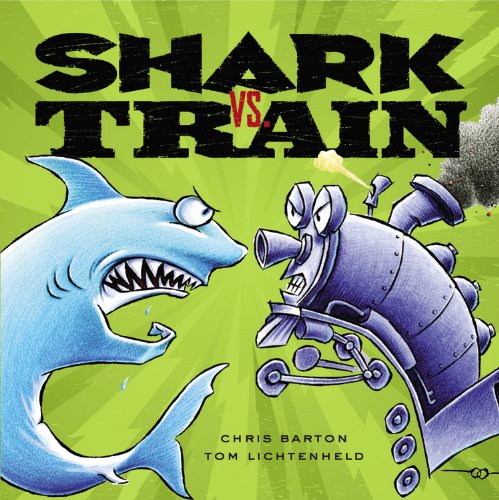
Shark vs. Train by Chris Barton, illustrated by Tom Lichtenheld
Two young boys dash to the toy box and dig around. One emerges with a shark toy while the other brandishes a toy train. So now the sides are clear, but which toy would win a battle? Well, that all depends! Would it be underwater or on train tracks? Would they be eating pies or having a burping contest? The ideas of the sorts of competitions will have readers giggling in delight as the shark wins one and then the train wins the next. Each competition is illustrated for humor and the reasons for winning are often surprising and funny. Get this book into the hands of children as quickly as you can!
Barton’s text is kept simple and easy. He frames the competition and then steps back to witness who wins. Towards the end, the competitions get wilder and neither shark nor train are comfortable. The book ends with the two boys being called to lunch. The illustrations are a large part of the pleasure and success of this book. The emotions on the faces of both shark and train will have readers quickly understanding the situation. There are small touches and asides in the illustrations that bring the story depth and added humor.
This book is sure to be popular in any library. Place it face out and it will disappear. The only question is whether it is the shark or train that gets the book more attention. Competition anyone? Appropriate for ages 4-7.
Reviewed from library copy.
View Next 5 Posts




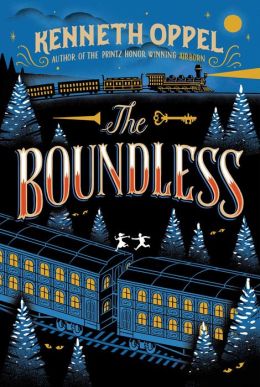






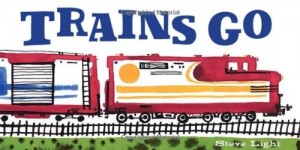
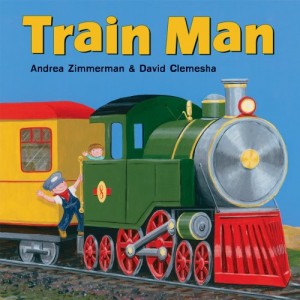
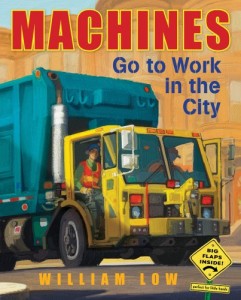
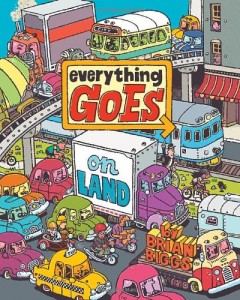
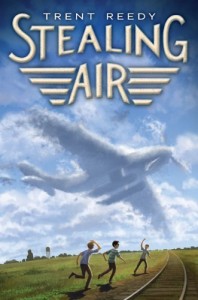










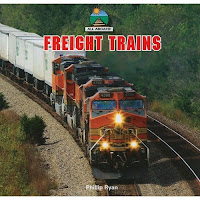







![Reblog this post [with Zemanta]](http://img.zemanta.com/reblog_e.png?x-id=f40c1561-dbcf-46a1-a964-9ed361406672)
We need to check out Christopher Niemann's "Subway"!
This does sound like it could be a good book to read with a child of newly-divorced parents.
I love subway books -- we'll need to check this one out.
I've been reading and enjoying your blog, and have given you a Liebster Award, which you can read about here: http://annieandaunt.blogspot.com/2012/02/little-love-for-our-fellow-kid-lit.html
Annie
This sounds so sad. I think I'll skip this one for the time being.